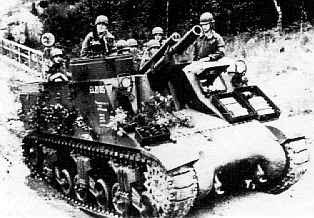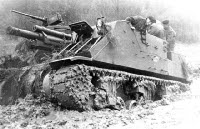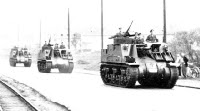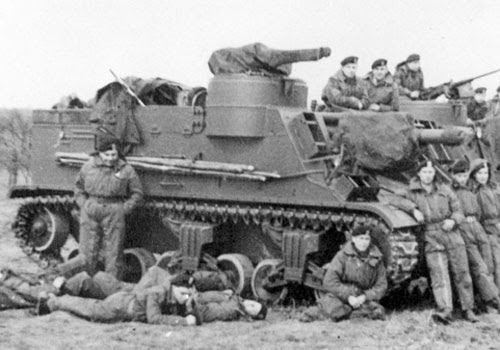- Yes
- No
- (independent) BeNeLux tree
- France: BeNeLux subtree
- other
- no/negative
TL;DR: The Belgian M7 Priest, a US-supplied 105 mm SP howitzer, in service with Belgian armored artillery regiments from 1951 to the late 1950s.
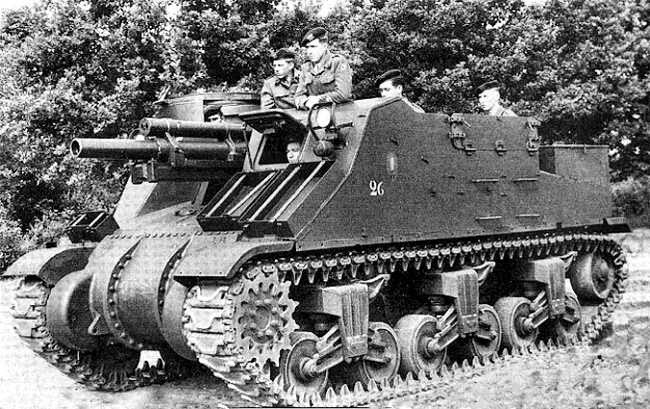
History & Service
History
The M7 Priest was designed in 1941–1942 on the chassis of the M3 Lee medium tank, mounting the 105 mm M2A1 howitzer in an open-topped fighting compartment. It gained its nickname from the pulpit-like machine gun position. Over 4,000 Priests were built by American Locomotive Co., Federal Machine & Welder Co., and Pressed Steel Car Co. Production later shifted to the M7B1 variant, built on the M4A3 Sherman chassis with a Ford GAA V8 engine.
The vehicle proved invaluable in US and British/Commonwealth service during World War II, offering mobile fire support in every major theater.
Belgium received 20 M7 Priests from the United States in 1951, as part of early NATO military aid. They were issued to the artillery regiments of the 16th Armored Division:
- 17e Régiment d’Artillerie à Cheval
- 18e Régiment d’Artillerie à Cheval
- 19e Régiment d’Artillerie à Cheval
In addition, between 1952 and 1957, the 2e Régiment de Chasseurs à Cheval also fielded a battery of M7 Priests.
By the late 1960s, the M7s were gradually phased out as Belgium modernized its artillery with newer systems such as the M44 and eventually the M108/M109 series. In 1969 they were fully retired from Belgian service. Still, the M7 Priest marked Belgium’s transition from towed to mechanized artillery and was one of the first NATO-standard SPHs to serve in its postwar army.
Transfer Data (SIPRI)
Recipient Supplier Designation Description Weapon Category Order Year Number Ordered Delivery Years Belgium United States M7 105 mm Self-propelled gun Artillery 1951 20 1951 Technical Description
Design & Features
The Belgian M7 Priests were standard vehicles identical to US production models.
They weighed about 22.9 tons, measured 6.02 m long, 2.87 m wide, and 2.54 m high, and carried a crew of 7 men.
The main weapon was a 105 mm M2A1 howitzer, with a maximum range of 11 km, a rate of fire of 4–5 rounds per minute, and an onboard ammunition stowage of about 69 rounds. For close defense, a .50 cal Browning M2HB machine gun with 300 rounds was mounted in the pulpit-style ring mount.
Armor protection ranged between 12–51 mm, offering defense against small arms and shrapnel. The vehicle was powered by either a Continental R975 C1 radial engine (400 hp) or, in the M7B1, a Ford GAA V8 (500 hp). Top speed was around 38–40 km/h, with a maximum road range of 190 km.
While vulnerable in direct engagements due to its thin armor and open top, the M7 was effective in its intended role of mobile, mechanized artillery support.
Specifications
Characteristic Data Origin United States (supplied to Belgium) Manufacturers ALCO, Federal Machine & Welder, Pressed Steel Car Chassis M3 Lee (M7) Weight ~22.9 tons Dimensions L: 6.02 m / W: 2.87 m / H: 2.54 m Crew 7 Engine Continental R975 C1 radial (M7) Power 400–500 hp Speed 38–40 km/h Range ~190 km Primary Armament 105 mm M2A1 howitzer Maximum Range ~11 km Rate of Fire 4–5 rounds per minute Ammunition Stowage ~69 rounds Secondary Armament 1 × 12.7 mm Browning M2HB (300 rounds) Armor 12–51 mm
Place in War Thunder
In War Thunder, the Belgian M7 Priest would serve as an early Cold War-era SPH for the BeNeLux subtree (or under France as a BeNeLux vehicle). It would likely sit at Rank II–III, similar to the suggested US M7 Priest (Early Production) - The Iconic American Self-Propelled Howitzer.
Its role would be that of a mobile artillery support vehicle: a powerful 105 mm gun with flexible HE, smoke, and HEAT shells, but counterbalanced by its slow speed, thin armor, and open-top vulnerability. This would make it a valuable addition to Belgium’s early artillery lineup, bridging the gap to heavier SPHs like the M55.
Pictures
Pictures
Sources
Sources
- Forty, George, M4 Sherman. Poole: Blandford Press, 1987 (ISBN 0 7137 1678 9)
- Pacco, John, Belgisch Leger / Armee Belge: Tanks en pantservoertuigen / Chars et vehicules blindes 1946-1996. Aartselaar: J.P. Publications, 1997 (ISBN 90-801136-3-8)
- Chamberlain, P., & Ellis, C. (1969). British and American tanks of World War Two: The complete illustrated history of British, American and Commonwealth tanks 1939–1945. Cassell & Co.
- Hunnicutt, R. P. (1970). Sherman: A history of the American medium tank. Presidio Press.
- SIPRI. (n.d.). Arms transfers database. Stockholm International Peace Research Institute. https://armstrade.sipri.org/armstrade/
- Nevington War Museum. (n.d.). Belgium tanks. Retrieved from https://www.nevingtonwarmuseum.com/belgium-tanks.html
- Wikipedia contributors. (2024, August 24). M7 Priest. In Wikipedia. https://en.wikipedia.org/wiki/M7_Priest
- Musée Royal de l’Armée, Brussels. (n.d.). L’obusier automoteur américain M7 Priest. Archival collection.
